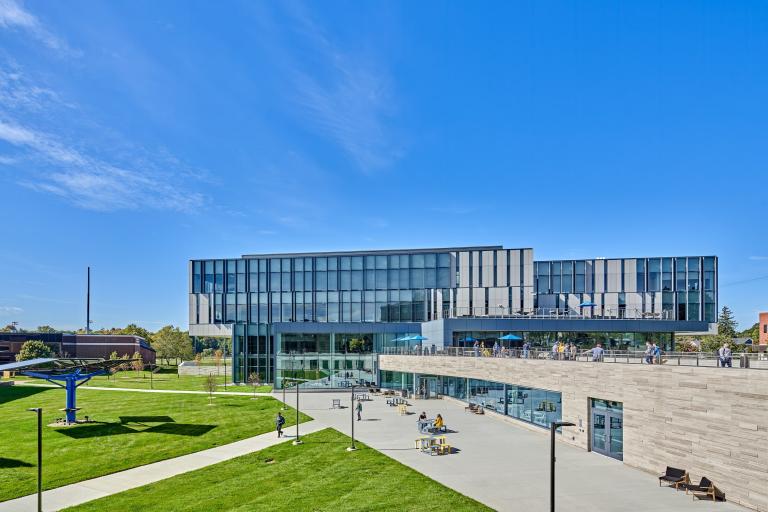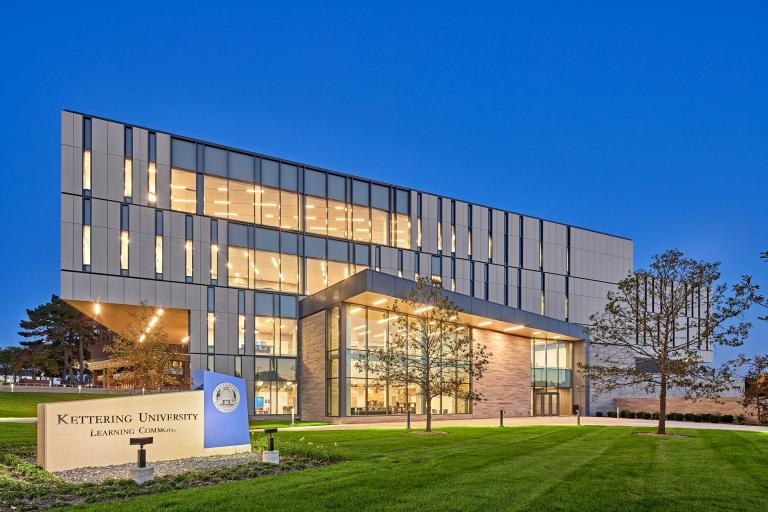

“This layered space emphasizes connectivity yet incorporates very individual spaces.”
Architects and design professionals have heaped praise on the bold, innovative design of the Learning Commons, validating what Kettering University President Dr. Robert K. McMahan has called "a revolution in how universities conceptualize space." 
The 105,000-square-foot Learning Commons earned the Grand Prize for higher education projects over 100,000 square feet at “Learning By Design” magazine's Fall 2023 Architecture and Interior Design Awards of Excellence program.
"This is truly a visionary project not just for Kettering, but for the city of Flint, and for higher education across the globe,” an article in “Learning By Design” stated. “The Learning Commons marries technology and craft, academics and social, education and industry together within a facility that makes a statement for where higher education must go.”
Construction on the Learning Commons began Feb. 5, 2020. The University had a soft opening for the $63 million facility in July 2022 before its grand opening in September. The building includes a dozen d.spaces (collaboration spaces); a 200-seat auditorium; a 15,000-square-foot Maker Space; 1,600 square feet of rooftop space with hammocks and additional seating; an art gallery; and a meditation room.
“The Learning Commons transcends mere architecture; it symbolizes our distinctive and collaborative educational approach,” McMahan said. “Serving as the vibrant center of campus interaction, our students, faculty and staff are thriving within this space, surpassing our initial vision. Kettering has redefined the national perception of university spatial design. And we couldn’t be more proud.”
Designed with no offices or classrooms, the building has become the centerpiece of campus for social and academic interactions.
“The Learning Commons nicely integrates workplace and academic experiences,” one judge commented. “It provides a variety of spaces to meet, gather and study. The building is layered with different spaces and needs for the students from interior to exterior. The atrium is a dynamic space that seems to buzz with activity.”
Its abundant natural light and wide-open, technology-enriched spaces infuse energy throughout and enrich collegiality, collaboration and innovation.
“It’s built to encourage behaviors, not to provide space for a specific function,” McMahan said.
And it does.
When a building is designed so people can stand on one side and see through to the other side with unobstructed views throughout, it’s easy to connect and start a conversation. The stairways also encourage this behavior because they aren’t stacked. This forces people to move laterally before they can move vertically.
All open or lounge-style seating areas in the Learning Commons are different, with no two areas furnished the same way. The spaces become less formal as you move from the first to the fourth floor, something the contest jury noticed.
“This layered space emphasizes connectivity yet incorporates very individual spaces,” a judge commented. “The project incorporates able daylight and a view to the surrounding campus.”
Educators, architects and design professionals recommended by the American Institute of Architects Committee on Architecture for Education and the Association for Learning Environments make up the jury who selected the award recipients. The projects were blind judged. The winners are featured in the October 2023 “Learning by Design” magazine issue.
This isn’t the first national recognition for the building. McMahan and representatives from Stantec gave a presentation about the Learning Commons at the 2022 Society for College and University Planners Annual Conference in Long Beach, California.
